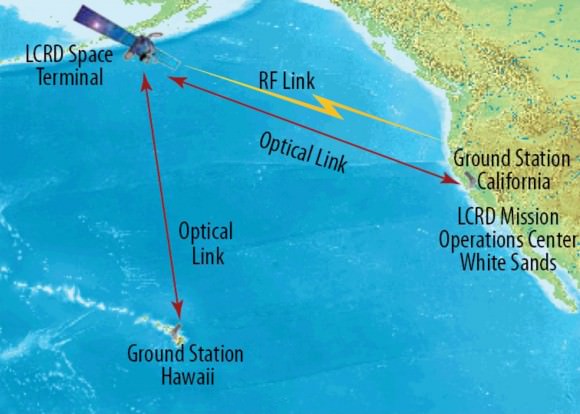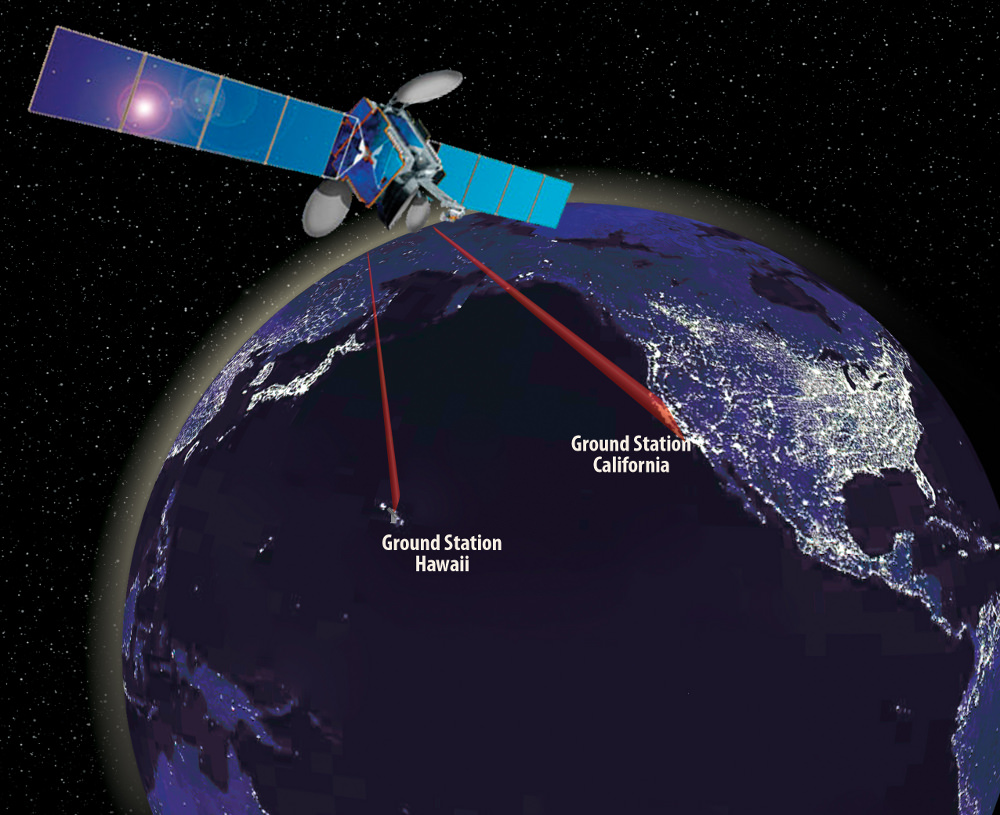[/caption]Quite often, communication rates with remote spacecraft have been a limiting factor when exploring our solar system. For example, it can take up to 90 minutes to transfer one high-resolution image from the Mars Reconnaissance Orbiter to scientists on Earth.
Improving data communication rates would allow scientists to collect additional data from future missions to Mars, Titan or other destinations in our solar system.
How does NASA plan to overcome the current limitations in communication with spacecraft outside Earth orbit?
One of three recently announced technology demonstrations, The Laser Communications Relay Demonstration, will help demonstrate and validate laser-based communications. One of many goals for the LCRD is to provide spacecraft in Earth orbit ( and beyond ) a faster and reliable method of communication than standard radio communications currently in use.
A laser-based communication will allow NASA and other government agencies to perform missions that require higher data rates. In the cases where less data is required, the laser-based systems would consume less power, mass and precious volume inside a spacecraft. Given roughly equal mass, power, and volume, the laser-based communications system offers much higher data rates than a radio-based communications system.
NASA’s goals for the LCRD are to:
Enable reliable, capable, and cost effective optical communications technologies for near earth applications and provide the next steps required toward optical communications for deep space missions
Demonstrate high data rate optical communications technology necessary for:
High-rate communications 10-100 times more capable than current radio systems will also allow for greatly improved connectivity and enable new generations of remote missions that are far more capable than today’s missions. NASA’s LCRD will also provide the satellite communication industry with technology not available today. Laser-based space communications will enable missions to use high-definition video and and pave the way for a possible “virtual presence” on a remote planet or other bodies in the solar system.
While the laser-based communications technology featured in the LCRD will allow more data to be sent from spacecraft to scientists on Earth, the communication delays (a few seconds for the Moon, and over twenty minutes for Mars) will still require careful mission planning.

The Laser Communications Relay Demonstration (LCRD) is led by the NASA Goddard Space Flight Center. Space Communications and Navigation (SCaN) office in the Human Exploration and Operations Mission Directorate is collaborating with the NASA Office of the Chief Technologist in sponsoring this technology demonstration.
If you’d like to learn more about NASA’s LCRD, you can read more at: http://www.nasa.gov/topics/technology/features/laser-comm.html


This is kind of common sense for space object to space object communication, but satellite to ground seems near impossible, plus unnecessary. The difficulty with satellite to satellite communication is (1) getting the receive/transmitter to line up precisely, even tighter then standard RF communication and (2) getting a communication standard to handle the instances where an object (such as a small asteroid) disrupts the path.
Lining up is a simple (relatively speaking) math problem, by precisely knowing the position of 2 objects to a specific resolution. As we further expand our deep space satellite network, the resolution will increase. To get a communication standard able to handle disruptions, the computer would need to understand the delay interval of a receipt acknowledgment, and store packets long enough to resend a dropped packet. The packet size would have to be small enough that the likelihood of a disruption was negligible. The further away an object was, the smaller the packet size needed.
For ground-to-satellite communication, cloud cover, atmospheric density, and constantly changing weather changes would disrupt the beam. Alternatively, if there were transmission satellites linked to a common data satellite, all problems would be solved. Essentially you would be creating a logical network route that sent all data between the end-point satellite and the earth-orbit data satellite to be stored for access/interaction by ground stations (and space stations if we ever get stable enough for that). This is no different then the current style of ground network connections, where fast speed connections are relays, and the speed slows down at the end-point level.
What is pulse microwave used for?
Microwave is part of the RF side of the EM spectrum, specifically 1mm to 1m wavelength (most of the atmospherically clear RF range). Remember that RF is any wavelength in the EM spectrum greater then 1mm, and that the atmosphere skews/distorts/blocks EM wavelengths in greater then 10m in the RF range, almost all infrared, and everything else except for visible light and ultraviolet.
Pulse is just another ways to say burst, and works in the same manner. Data is sent in a heap simultaneously. This is great for broadcast mediums such as video transmission, but not for bi-directional communication (which requires verifying successful reception. An example of use would be TV content providers. The source (broadcast building) usually sends a signal to a transmission tower or to a geo-stationary satellite as a microwave (high RF) pulse, which then rebroadcasts it out. Since there is no need to report back to the source that information was recieved, a pulse works great.
To picture the difference, look at the delay for between a satellite in Earth orbit to a satellite in Mars orbit. A 20 minute delay means a 40 minute acknowledgement window. This means a second attempt would have that data arrive 60 minutes later, a third 100 minutes later.
is there any way to block pulse microwave?
My guess is that a production system would use masers in order to also take advantage of how microwaves operate in atmosphere.
Incoming headlines about NASA orbital lasers in 3… 2… 1…
I was going to make a Dr. Evil / Austin Danger Powers joke involving sharks, but there wasn’t any way to do so without it being blatantly silly.
For long range point to point comms, the Lasers offer so many advantages it’s just silly.
Especially in the vacuum. Links to other environments can be made via more suitable EM spectral regimes. Would this be the first halting steps to the exonet?